Abstract
A survey was conducted on 30 halogenated public swimming pools, located in Albany, Schenectady, and Rensselaer counties, to determine their open-water limax amoeba densities. Six were outdoor pools. Other variables measured were the standard plate count, total seston, free residual chlorine or bromine, total alkalinity, total hardness, orthophosphate, total soluble phosphorus, specific conductance, pH, temperature, and several engineering parameters including the rate and type of filtration as well as a saturation index. Amoebae were isolated on agar plates at 37°C using heat-killed bacterial suspensions of Enterobacter cloacae or Escherichia coli. Most probable number estimates of amoebic densities ranged from not detectable (<0.01) to 110 amoebae per liter. The median concentration of amoebae was 0.9/liter. Eighty percent of the pools examined had less than 5 amoebae per liter. Significant correlations (P < 0.05) were found between amoebic densities and the log10 of the standard plate count, orthophosphate, and total soluble phosphorus. No significant difference was found between amoebic densities in outdoor and indoor pools. Preliminary tests for the presence of the human pathogen Naegleria fowleri were inconclusive.
Full text
PDF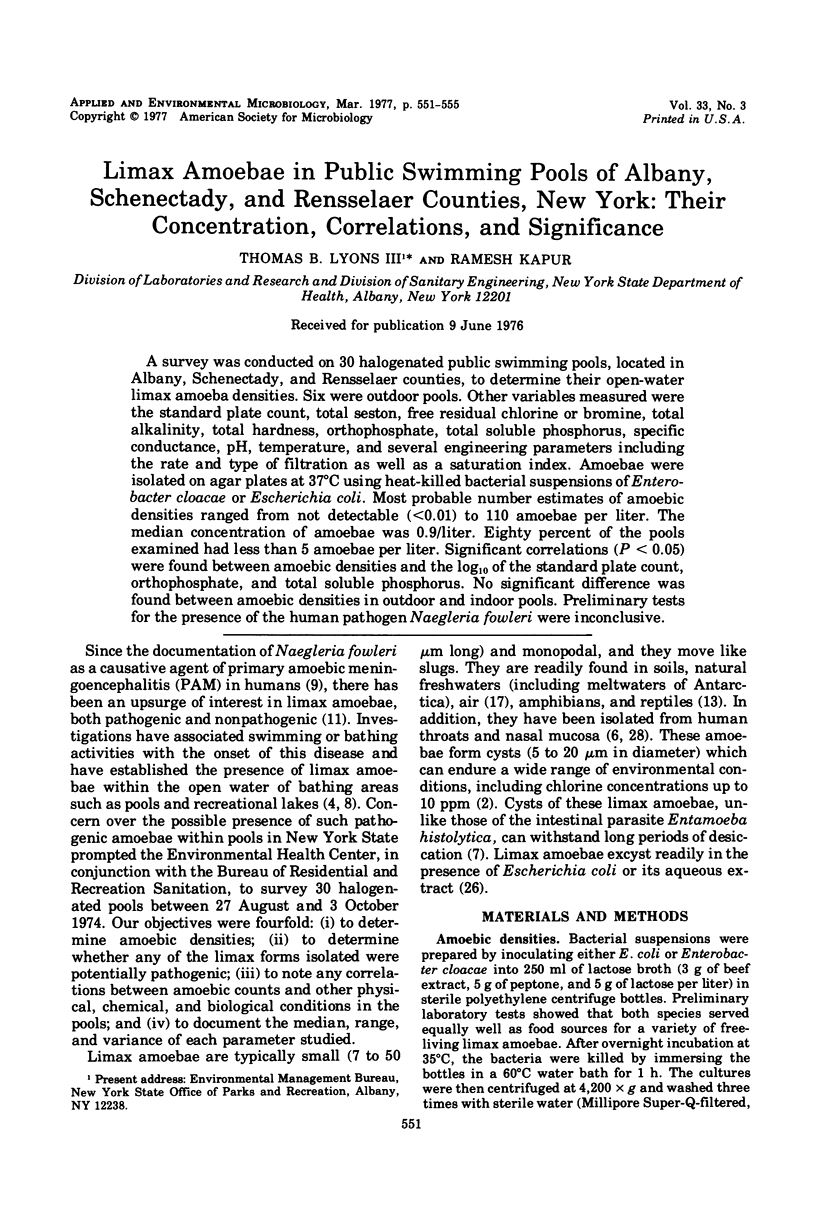
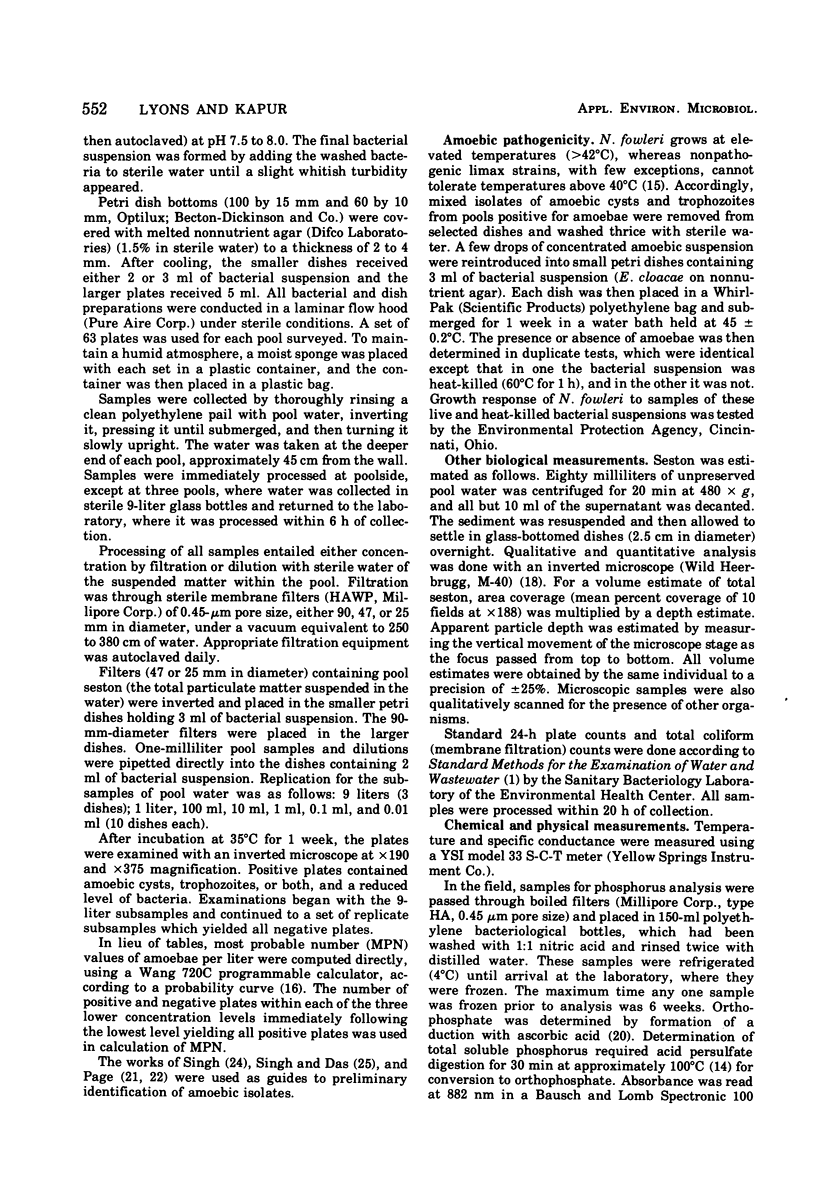
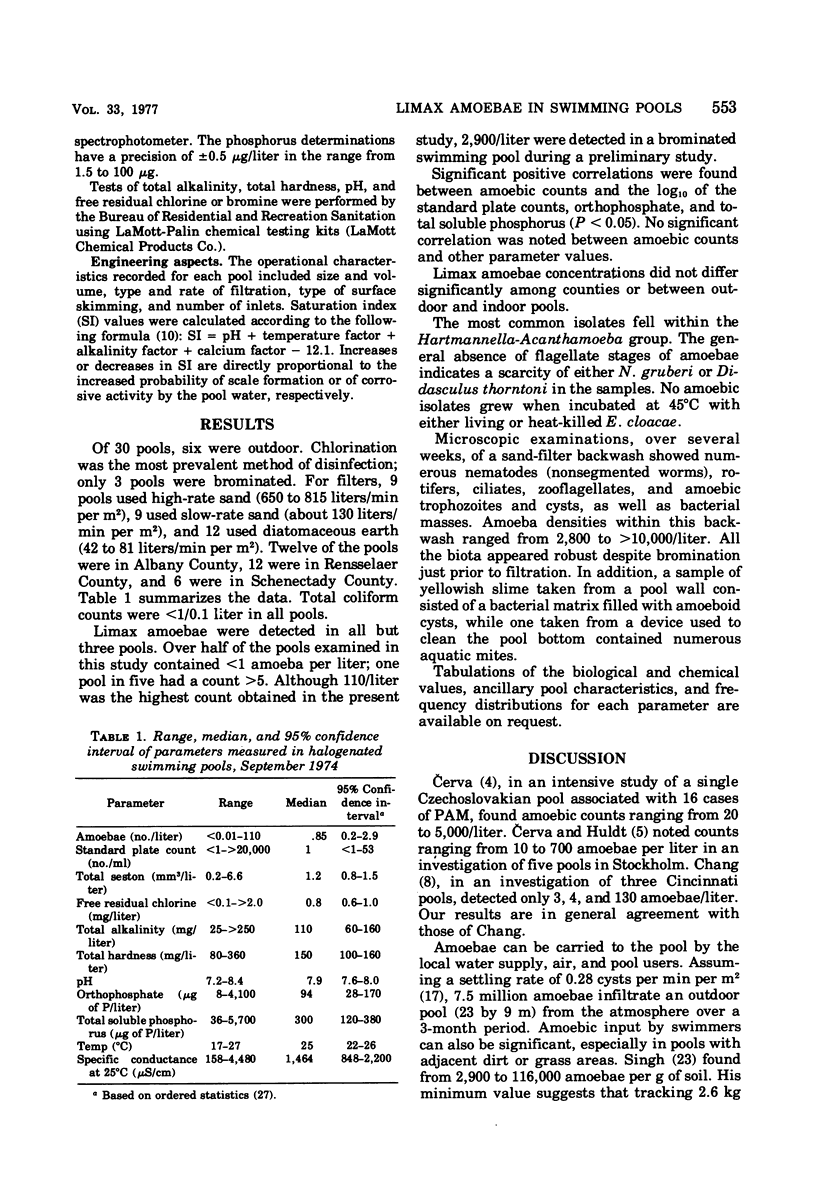
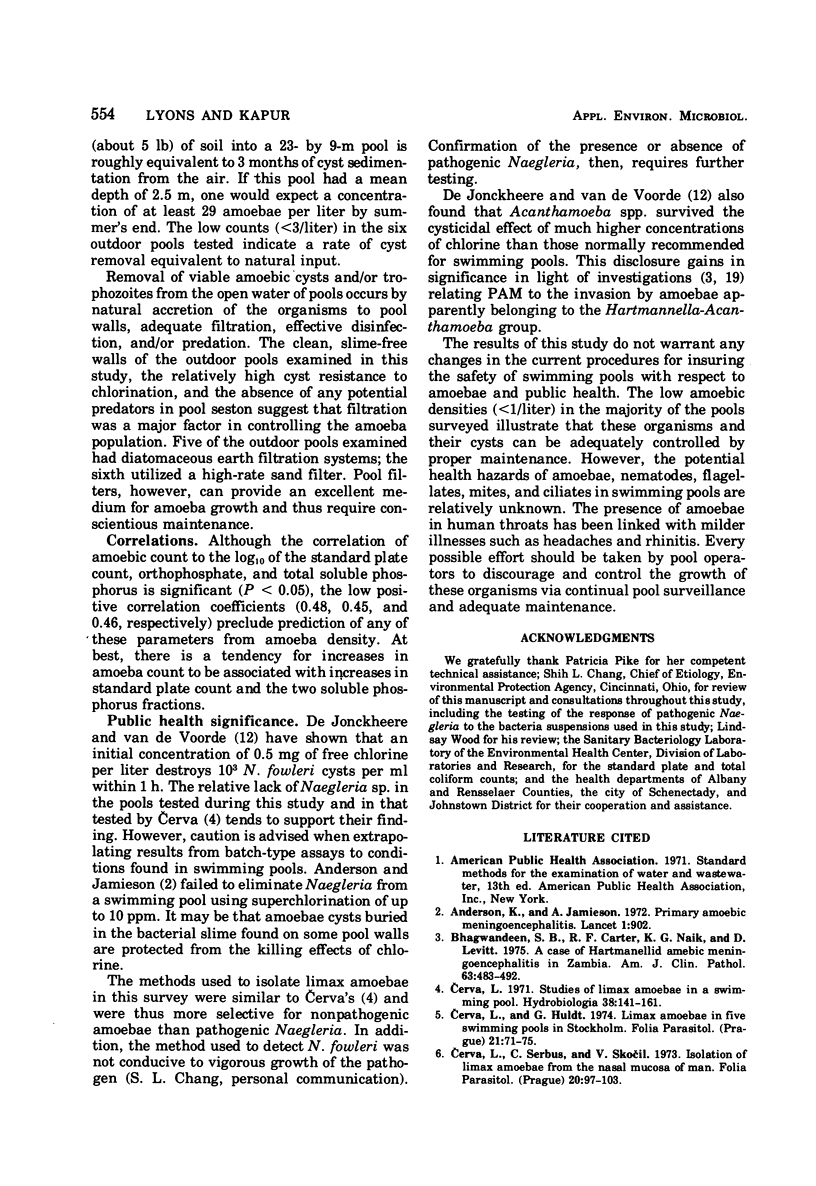
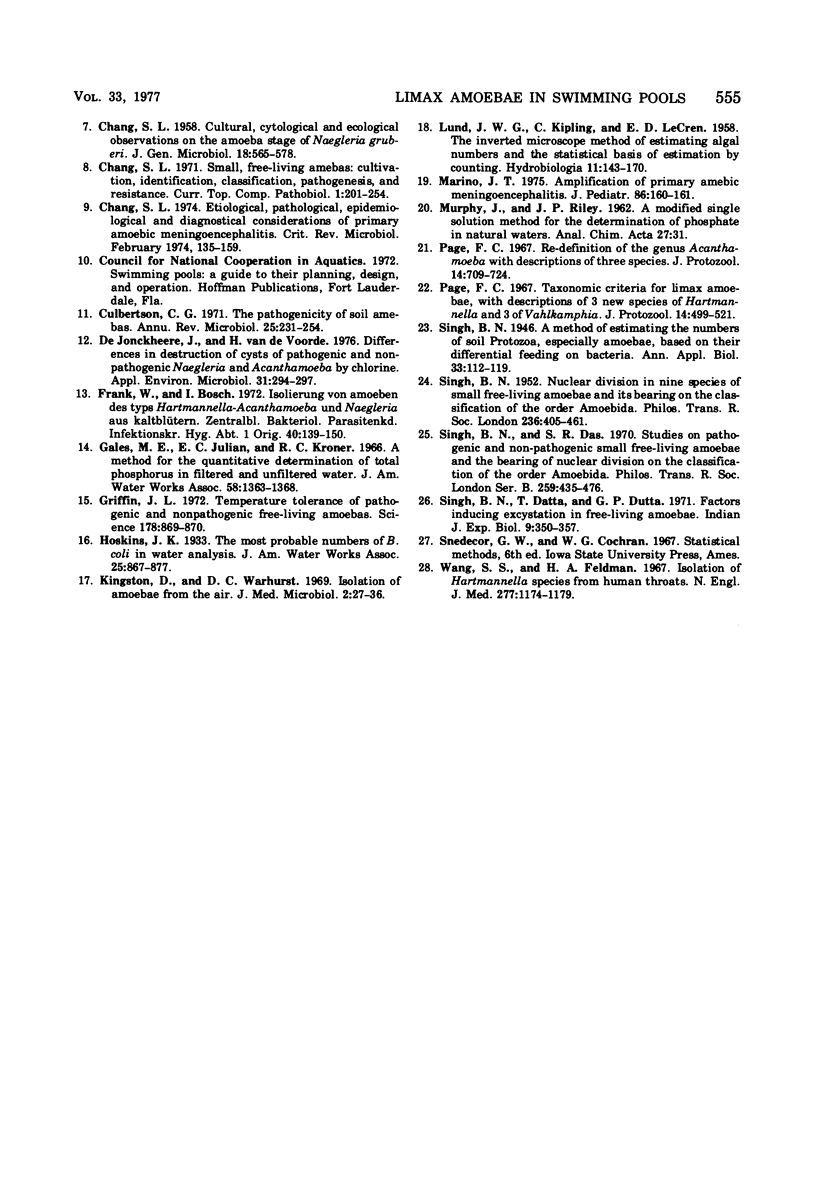
Selected References
These references are in PubMed. This may not be the complete list of references from this article.
- Anderson K., Jamieson A. Primary amoebic meningoencephalitis. Lancet. 1972 Apr 22;1(7756):902–903. doi: 10.1016/s0140-6736(72)90772-6. [DOI] [PubMed] [Google Scholar]
- Bhagwandeen S. B., Carter R. F., Naik K. G., Levitt D. A case of hartmannellid amebic meningoencephalitis in Zambia. Am J Clin Pathol. 1975 Apr;63(4):483–492. doi: 10.1093/ajcp/63.4.483. [DOI] [PubMed] [Google Scholar]
- CHANG S. L. Cultural, cytological and ecological observations on the amoeba stage of Naegleria gruberi. J Gen Microbiol. 1958 Jun;18(3):565–578. doi: 10.1099/00221287-18-3-565. [DOI] [PubMed] [Google Scholar]
- Cerva L., Huldt G. Limax amoebae in five swimming pools in Stockholm. Folia Parasitol (Praha) 1974;21(1):71–75. [PubMed] [Google Scholar]
- Cerva L., Serbus C., Skocil V. Isolation of limax amoebae from the nasal mucosa of man. Folia Parasitol (Praha) 1973;20(1):97–103. [PubMed] [Google Scholar]
- Chang S. L. Small, free-living amebas: cultivation, quantitation, identification, classification, pathogenesis, and resistance. Curr Top Comp Pathobiol. 1971;1:201–254. doi: 10.1016/b978-0-12-153401-1.50010-7. [DOI] [PubMed] [Google Scholar]
- Culbertson C. G. The pathogenicity of soil amebas. Annu Rev Microbiol. 1971;25:231–254. doi: 10.1146/annurev.mi.25.100171.001311. [DOI] [PubMed] [Google Scholar]
- De Jonckheere J., van de Voorde H. Differences in destruction of cysts of pathogenic and nonpathogenic Naegleria and Acanthamoeba by chlorine. Appl Environ Microbiol. 1976 Feb;31(2):294–297. doi: 10.1128/aem.31.2.294-297.1976. [DOI] [PMC free article] [PubMed] [Google Scholar]
- Frank W., Bosch I. Isolierung von Amoeben des Typs "Hartmannella-Acanthamoeba" und "Naegleria" aus Kaltblütern. Z Parasitenkd. 1972;40(2):139–150. doi: 10.1007/BF00329149. [DOI] [PubMed] [Google Scholar]
- Griffin J. L. Temperature tolerance of pathogenic and nonpathogenic free-living amoebas. Science. 1972 Nov 24;178(4063):869–870. doi: 10.1126/science.178.4063.869. [DOI] [PubMed] [Google Scholar]
- Kingston D., Warhurst D. C. Isolation of amoebae from the air. J Med Microbiol. 1969 Feb;2(1):27–36. doi: 10.1099/00222615-2-1-27. [DOI] [PubMed] [Google Scholar]
- Marino J. T. Letter: Amplification of primary amebic meningoencephalitis. J Pediatr. 1975 Jan;86(1):160–161. doi: 10.1016/s0022-3476(75)80740-2. [DOI] [PubMed] [Google Scholar]
- Page F. C. Re-definition of the genus Acanthamoeba with descriptions of three species. J Protozool. 1967 Nov;14(4):709–724. doi: 10.1111/j.1550-7408.1967.tb02066.x. [DOI] [PubMed] [Google Scholar]
- Page F. C. Taxonomic criteria for limax amoebae, with descriptions of 3 new species of Hartmannella and 3 of Vahlkampfia. J Protozool. 1967 Aug;14(3):499–521. doi: 10.1111/j.1550-7408.1967.tb02036.x. [DOI] [PubMed] [Google Scholar]
- Singh B. N., Das S. R. Studies on pathogenic and non-pathogenic small free-living amoebae and the bearing of nuclear division on the classification of the order amoebida. Philos Trans R Soc Lond B Biol Sci. 1970 Oct 22;259(832):435–476. doi: 10.1098/rstb.1970.0063. [DOI] [PubMed] [Google Scholar]
- Singh B. N., Datta T., Dutta G. P. Factors inducing excystation in free-living amoebae. Indian J Exp Biol. 1971 Jul;9(3):350–357. [PubMed] [Google Scholar]
- Wang S. S., Feldman H. A. Isolation of hartmannella species from human throats. N Engl J Med. 1967 Nov 30;277(22):1174–1179. doi: 10.1056/NEJM196711302772204. [DOI] [PubMed] [Google Scholar]


